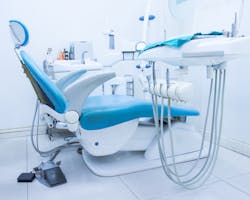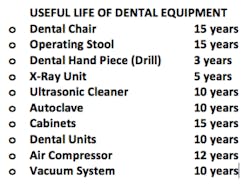Does it make sense to replace or repair your dental equipment? Knowing the best choice takes some patience and learning. Here are some tips from an expert to help you determine which is best.
_____________________________________________________________________________________________
This article originally appeared in the Principles of Practice Management e-newsletter. Subscribe to this informative twice monthly practice management ENL here.
It’s no surprise that dental equipment is one of the most significant expenses for a practice. The average cost of a complete dental chair set-up can cost up to $14,000. At some point, however, continually repairing old equipment becomes a waste of money. So, how do you prolong the life of equipment? What systems should be in place to help you determine when that old chair needs to go? At what point does it make sense to buy new? Answering these questions requires considering several key factors.
Evaluate, estimate, and allocate
Before deciding whether to repair or replace an expensive and indispensable piece of equipment, you need to carefully evaluate the unit’s age, usage, issues (ongoing or intermittent), warranty coverage, and practice financial resources. Also, determine a fair estimate of lost revenue due to equipment downtime, disgruntled patients, and reduced productivity. Consult staff and trusted repair technicians for their honest assessments and recommendations. Replacing equipment is expensive, but so is throwing good money into repeated repairs. If replacement is the best option, then set aside time to find the best equipment at a price your practice can afford. Let’s explore further.
1. Determine useful life
Reconditioning a compressor might be tempting. Before doing so, consider its age and reliability during the past year. If that compressor repeatedly failed or is more than 10 years old, reconditioning might not be worth the money and effort. Why? It’s a risky game of chance in guessing how many more years you’ll get after it’s reconditioned. Every capital item in a dental practice has an expected lifespan that depends on regularity of use. According to The Veterans Administration and the U.S. Army (1), the useful life of dental equipment breaks down this way:
Busy practices tend to see shorter equipment lifespans than practices that are a bit slower. Keep an equipment log that documents age, date of purchase, whether it was purchased new or used, repair records, and warranty coverage. When you know the remaining warranty coverage, you’re better able to make an educated decision about whether to repair or replace a piece of equipment.
2. Maintain, train, and gain
Maximizing and extending the useful life of your equipment requires meticulous care and regular maintenance performed by trained service technicians. Review maintenance requirements for each piece of equipment because some may need more frequent servicing. Having good relationships with service technicians is a great asset. Experienced and trusted technicians will be straightforward with you when the costs of continual repair outweigh the efficiency of replacing equipment. Finally, it is imperative to train staff on how to properly use and maintain equipment. It reduces the likelihood of damage and high-cost repair, which might not be covered under warranty.
3. Audit equipment every year
Set aside time every year to complete a thorough audit of practice equipment. Conduct this audit when you’re reviewing year-end financials and planning budgets. Here’s how to conduct a comprehensive equipment audit:
1. Create a detailed list of all units.
2. Log frequency of repairs plus repair downtime (1+ days) by unit.
3. Regularly collect team feedback about performance and recommendations.
4. Assess a rating system to each unit’s performance and reliability. (A simple 1 to 5 rating scale is commonly used by dental practices.) This becomes your early warning system, helping pinpoint what equipment should be first for replacement.
4. Set aside money
What good is a reliable warning system to detect equipment that needs replacement if you don’t have the financial resources to cover those expenses? Set aside 2% to 3% of annual earnings each year into a capital expense fund to cover any necessary and unexpected improvements. This way you’re less likely to scramble when determining how to pay for any needed piece of equipment. Plus, you won’t need a loan, which means no interest fees.
Preparedness is key
There’s no doubt about it, preparation is key to capital equipment management. When you take stock of your equipment—how well it performs, how well it’s maintained—you have an automatic, built-in monitoring system. We all know there’s no such thing as maintenance-free equipment or equipment that runs forever. Getting the most out of your equipment and extending its useful life requires proper care, regular service, and well-trained staff. Don’t forget to set aside money every year for needed replacements or upgrades. These four strategies can help you get your hard-earned money’s worth out of practice equipment and know confidently when it makes sense to repair or replace.
For the most current practice management headlines, click here.
For the most current dental headlines, click here.
Reference
(1) “Safety Net Dental Clinic Manual.” Chapter 2: Facilities and Staffing, Safety New Dental Clinic Manual, The National Maternal and Child Oral Health Resource Center, 2011, www.dentalclinicmanual.com/chapt2/2_11.html.








